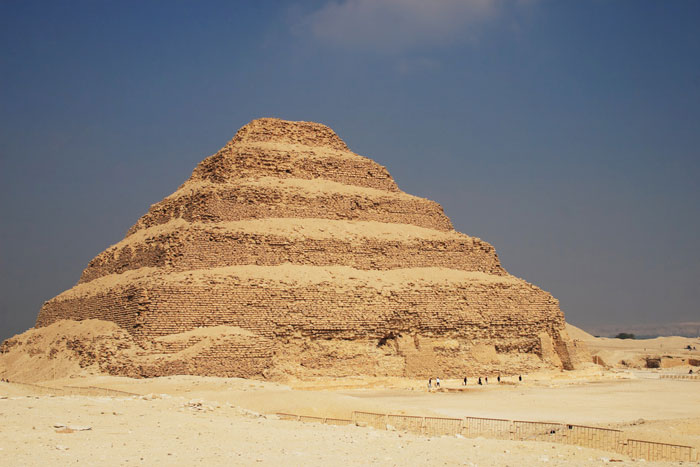Mysterious around the oldest pyramid in Egypt
Built at Saqqara about 4,700 years ago, the ladder pyramid Djoser was the first Egyptian pyramid.
Djoser is sometimes spelled Zoser, (despite the fact that he is called Netjerykhet) as the third dynasty king of Egypt.
The planner of building the pyramid was Imhotep, the minister of the dynasty was then revered as a saint thanks to his contributions.
The pyramid originally originated as a mausoleum of Mastaba - a parallelogram-shaped architecture, which undergoes a series of construction work that formed a 60-meter-high pyramid with six floors stacked on each other.
The construction of the pyramid requires 11.6 million cubic meters of stone and clay. The tunnels below the pyramid form a path about 5.5 km long.

Terraced pyramid Djoser is Egypt's oldest pyramid.
Complex area
The pyramid is located in the center of a complex of about 15 hectares, surrounded by a limestone wall of 13 fake doors as well as a real path in the southeast.
A temple is located north of the vertical pyramid with the monument of the king. The monument surrounded by small stone architecture is known as 'serdad'. To the south of the pyramid is a palace surrounded by an altar and rocks.
Many of the facade buildings were built in the complex, including a series of small churches in the southeast as well as north and south hallways east of the pyramid. Structures for religious purposes.
To the southeast of the complex, next to the small churches is a palace that was probably built for the king to organize Hed festivals - Seb in the afterlife.
At the south end of the complex is a mysterious tomb with a small church. It consists of a series of tunnels that mimic the style of tunnels found beneath the pyramid. What is buried there is a secret.

A small church in the Hep-Sed palace in the Djoser ladder pyramid.
Tomb of the King
Beneath the terraced pyramid is a row of tunnels and rooms, centered on a 28-meter-deep tunnel at the bottom of the tomb of King Djoser.
Recent conservation work in the tomb uncovers the king's granite coffins and the names of the queens are still readable.
Egyptologist Zahi Hawass, former director of the Egyptian Supreme Council in a video in 2009, said about the conservation work in the pyramid: 'The pyramid is the only pyramid in the tide. the ancient era where eleven of the king's daughters are buried inside ".
The original tomb can be decorated with limestone blocks containing pentagrams forming a starry ceiling. However, for some reason, this decoration was removed by builders instead of a simpler burial room of granite.
Underground tunnels and palaces
The two paths lead to the underground and divide into three directions. There were three galleries, a special small cellar containing food, and an unfinished room that could have been built as a palace on the ground of the afterlife.
The three false doors contain motifs showing the king's religious cult. The chamber is decorated with thousands of blue porcelain tiles imitating a reed-shaped projection in the King's palace in Memphis. The room below this pyramid was completed quickly.
Another tunnel, which begins on the north side of the pyramid, contains 40,000 stone bowls, many of which belong to the king's ancestors. The coffins and parts of the remains were also found.
Conservation today
The ladder pyramid is an unsustainable construction with predictions that if there is no conservation work, the tunnels below the pyramid may collapse and the monument may lose a significant part in one. several more decades.
The Egyptians began a heritage conservation effort many years ago and recently Cintec, a British construction company, was mobilized to support conservation efforts. They used large airbags to support the pyramid roof while performing the pyramid structure repair work.
Honor
With the construction of the ladder pyramid, Imhotep was finally worshiped as a saint. Egyptologist Marc Van De Mieroon wrote in his book 'History of Ancient Egypt' that King Djoser gave Imhotep a favor, allowing his name and title to be carved into the monumental base of the king.
Reference: Livescience
- Secret of the red pyramid in Egypt: After 141 years of decoding a part
- Discover the oldest pyramid-like tomb in the world
- Unravel the mystery of the largest pyramid in Egypt
- Egypt's oldest pyramid airbag
- Two cavities cannot be explained in the Great Pyramid of Egypt
- Explore the tunnel in Cheops pyramid
- The discovery of the site is said to be the oldest pyramid
- Mystery of the American Pyramid
- Discovering the first pyramid of humanity, building 1000 years before the Egyptian Pyramid
- The spell of the spell on the Pyramid tombstone
- What do you know about Gunung Padang - 'The 20-year-old pyramid' is extremely mysterious
- Egypt found the pyramid for the queen
 The truth about the mysterious red-haired giant at Lovelock Cave
The truth about the mysterious red-haired giant at Lovelock Cave Inunaki Tunnel: The haunted road leading into Japan's 'village of death'
Inunaki Tunnel: The haunted road leading into Japan's 'village of death' The mystery of the phenomenon of human reflection before dying
The mystery of the phenomenon of human reflection before dying 6 mysterious phenomena, although science has been developed for a long time, still cannot be answered
6 mysterious phenomena, although science has been developed for a long time, still cannot be answered